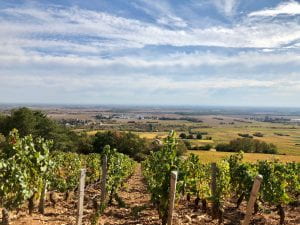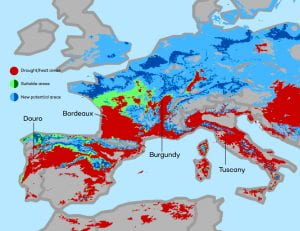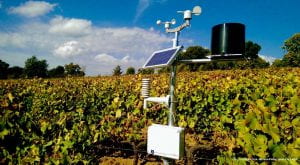Some regions are said to have more ‘terroir’ than others.[1] Terroir is how a particular region’s climate, soils and aspect (terrain) affect the taste of wine. Among environmental factors, climate has a greater impact on vine development and fruit composition compared to soil and grapevine variety.[2] Prices in the same year for wines from the same grape type can vary enormously depending on where the grapes were grown, with grapes grown in more conducive climates fetching a much higher price.
Of all the elements, temperature is critical to wines. Not only does precise temperature determine the enjoyability of the liquid in your glass, it also changes the whole vine phenology – that is, the date on which vine bud breaks, flowers, and ripens. This relation is so strong that vine phenology can be predicted by models that are based only on temperature.[3]

The warming climate is expected to lead to a “huge shake-up in the geographic distribution of wine production” in the coming decades[4] and push vineyards to extreme frontiers. Some wineries, like that of the famous Catena family in Argentina, see one solution in planting vineyards at much higher altitudes. Others are heading farther north to more marginal climes. One study suggested that by 2050, many regions in Europe, including much of Italy and swaths of Southern France, could become unsuitable for wine grapes. The same study suggested that California production could fall by 70 percent by the century’s midpoint.[5]

Yet, for the majority of winery operators, immediate geographical relocation may not be a real option. Instead, some may choose transform their vineyards to become much more adept at responding to the changing climates.
Take Jackson Family Wines – one of the largest wineries in the US. To ensure the vines are not exposed to weather extremes, the management installed a solar-powered weather station. If the sensors decide it has become too cold in the middle of the night (climate change, of course, doesn’t mean it’s always hot), new wind machines will automatically start circulating warm air to protect the vines.[6]
Although there is general agreement that climate change will result in rising temperatures, the impact on precipitation is far less certain. Precipitation may increase in higher latitudes and decrease in lower latitudes. Because of these uncertainties, most analyses of climate change’s impact on viticulture grape growing focus on changes in temperatures and do not consider changes in rainfall.
The Jackson Family, however, have seen a sharp decrease in rainfall since they started planting grapes in California in the mid 1970s. To optimize water usage, the family put in place a system of more than 100 inter-connected reservoirs scattered across the vineyards. The reservoir is connected to a gravity-fed drip irrigation system that pulls the water down the hills and through the vineyards. It now provides most of the water for the winery, which previously relied on wells and rain.[7] Beyond just smart farming, they aim to redefine business as usual and lead the industry with commitments to renewable energy, onsite energy storage, greenhouse gas emissions reductions, water conservation and waste management.

One might think that these are far-fetched issues to ponder. However, vineyards of the future is likely to feature wide-spread automation whereby information will be collected, processed by algorithms which will then present options to growers in real time through their mobile devices so they can make informed decisions quickly. [8]As climate change will soon make current wine-growing areas unsuitable for grape vines, these intelligent features might turn out to be critical to the winery’s ongoing commercial viability.
Lastly, apart from long-term survival, is there evidence to believe that consumers would be supportive of such environmental initiatives – through higher willingness to pay – that Jackson Family Winery undertake? Are you willing to pay more for sustainably produced wines? How do you actually know that the wine-making practice is actually sustainable? For now, unfortunately there is not much one can do right now, except to pick lighter wine bottles and complain to your favorite winemakers about heavier ones. There are encouraging signs, though, such as Porto Protocol, an initiative that aims to inspire companies and individuals to do more to fight climate change, bringing politicians, scientists and wine companies together to discuss climate change and possible solutions.[9]
Maybe, the simplest solution could be to start drinking wines dispensed from a keg[10]. Or the next time you buy wines en primeur[11] from Château Lafite Rothschild, demand them send your allocations in a boxed wine format instead.[12]
This blog post is contributed by Keane Nguyen, Rymax, Fanfan Liang, and Songsong Zhao. All are INSEAD MBAs from the class of July 2019.
[1] Terroir Definition. Wine Foly. Retrieved at https://winefolly.com/tutorial/terroir-definition-for-wine/
[2] van Leeuwen, C., Friant, P., Choné, X., Tregoat, O., Koundouras, S., and Dubourdieu, D. (2004). Influence of climate, soil and cultivar on terroir. American Journal of Enology and Viticulture, 55(3), 207–217. Retrieved at https://pdfs.semanticscholar.org/c645/887e854244794db9c201995e19a12cb7bcbd.pdf
[3] Parker, A., Garcia de Cortazar Atauri, I., van Leeuwen, C., and Chuine, I. (2011). General phenological model to characterise the timing of flowering and véraison of Vitis vinifera L. Australian Journal of Grape and Wine Research, 17(2), 206–216.
[4] Lallanilla, M. (2013) Will Global Warming Crush the Wine Industry? Live Science. Retrieved at https://www.livescience.com/28577-wine-global-warming.html
[5] Lee, H. Climate Change Will Put the Squeeze on World’s Wineries & Wilderness. Conservation International. Retrieved at https://blog.conservation.org/2013/04/climate-change-puts-the-squeeze-on-wine-production/
[6] Gelles, D. Falcons, Drones, Data: A Winery Battles Climate Change. New York Times. Retrieved at https://www.nytimes.com/2017/01/05/business/california-wine-climate-change.html
[7] Ibid.
[8] For inspiration, see Vineyards of the future – think Automation. Retrieved at https://www.farmprogress.com/grapes/vineyards-future-think-automation or A chat with dr. Sigfredo Fuentes about Vineyard of Future. Retrieved at https://thedigitalwine.com/a-chat-with-dr-sigfredo-fuentes-about-vineyard-of-future/
[9] More details at The Porto Protocol – Wineries Confront Climate Change. Retrieved at https://www.portoprotocol.com/the-porto-protocol-wineries-confront-climate-change/
[10] Asimov, E. On Tap? How About Chardonnay or Pinot Noir. New York Times. Retrieved at https://www.nytimes.com/2009/04/08/dining/08pour.html?module=inline
[11] En primeur or “wine futures”, is a method of purchasing wines early while the wine is still in the barrel.
[12] Asimov, E. Thinking Inside the Box. New York Times. Retrieved at https://www.nytimes.com/2011/08/03/dining/reviews/boxed-wines-review.html?module=inline

Interesting. I think it relates to my article about how food processors, dependent of crop farmers will react to climate change. I feel like wine producers may be more impacted since family businesses typically do not have the resources of a giant corporation behind them to be more nimble and move if conditions worsen permanently.
I wonder if there are alternative ways of producing wine. Could wine be produced using hydroponic methods? My understanding is hydroponic methods are energy and water intensive, so I wonder if that would be a viable alternative (assuming you use clean energy and recycle the water. It would be interesting to investigate.
I love the questions you ask at the end about consumer willingness to pay for these sorts of sustainability initiatives. My instinctive answer would be yes – I think demand in this industry is fairly price-inelastic, and so much if the industry is built around long-term brands and heritage that i’d assume consumers care about the sustainability of production.
This also means there might be more value in wineries investing in tech to mitigate the impact of climate change, rather than just moving to new locations and losing this link with the past / the community.
I agree with Alex that the consumer’s willingness to pay is a critical aspect. Another perspective could be that wineries with strong brands which are already selling at higher prices and earning higher margins, will be the ones with the financial resources to take the lead and pursue sustainable production.
Great article! I think geographic relocation shouldn’t be dismissed too quickly. The silver lining here is that it simply is possible.
When I compare this to our article about ski resorts, where moving North, West or South doesn’t do you any good since you won’t find mountains.
I mean, North of France are the UK and the Netherlands, which may start growing grapes at some point in time but will never host ski resorts.
I believe “smart agriculture” is the likely future of agriculture. With new technology that allows temperature to be controlled or automatic and detailed watering of soil, farmers will be able to have a complete control over their crop while using less resources and counter-acting against the effects of climate change. It’s true that costs will increase but this is the case for almost all technology developments and people will adapt since at some point that will be the only way of continue consuming wine. Furthermore, technology advances will at some points decrease costs of production as more advance devices start to be produced in larger scales. A short term strategy is to focus on the growing green market, willing to pay more for environmental sustainable products.
Great read! Found this very similar to climate change on the chocolate industry especially when you talked about the effects of increasing temperature and variable rainfall patterns and quantities.
I like that the post brought in customer actions that could be undertaken and questions that we can ask as early as our next wine purchase to be more aware of where the wine is coming from. I agree with Lucas’ point about smart agriculture and do believe that this is important to mitigate the indiscriminate use of resources that will only worsen the climate change problem and harm surrounding ecosystems.
This is an interesting analysis of the wine industry and potential impacts from climate change. I would be interested to learn about how this disjointed industry, comprised of family businesses, corporations and other types of organizations, are working together to combat these issues.